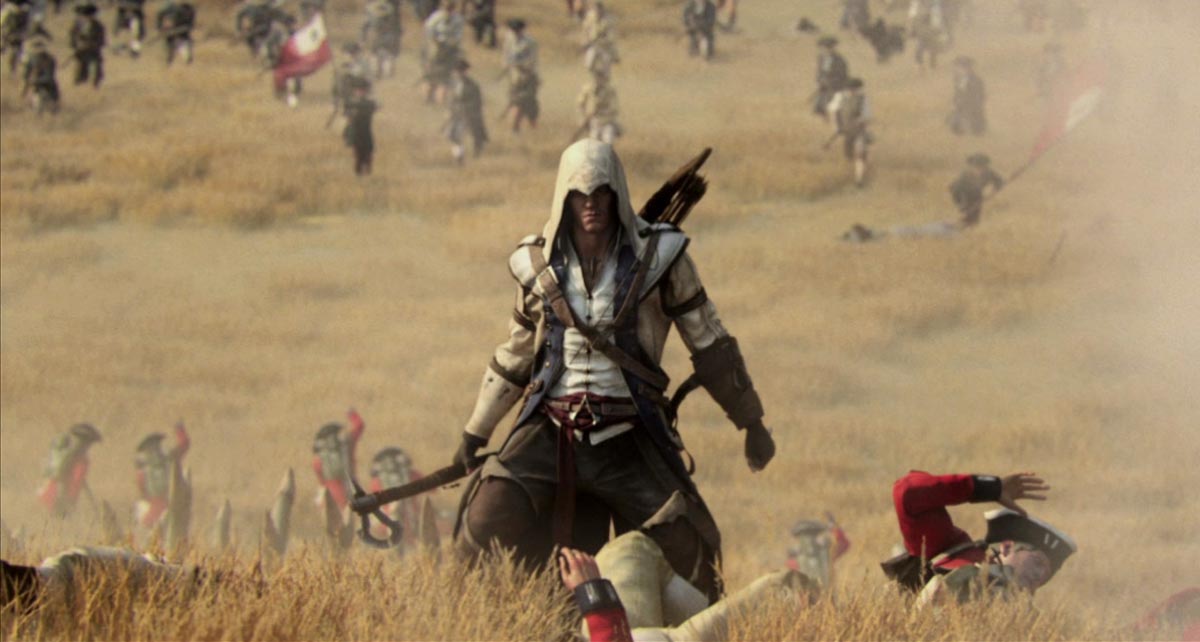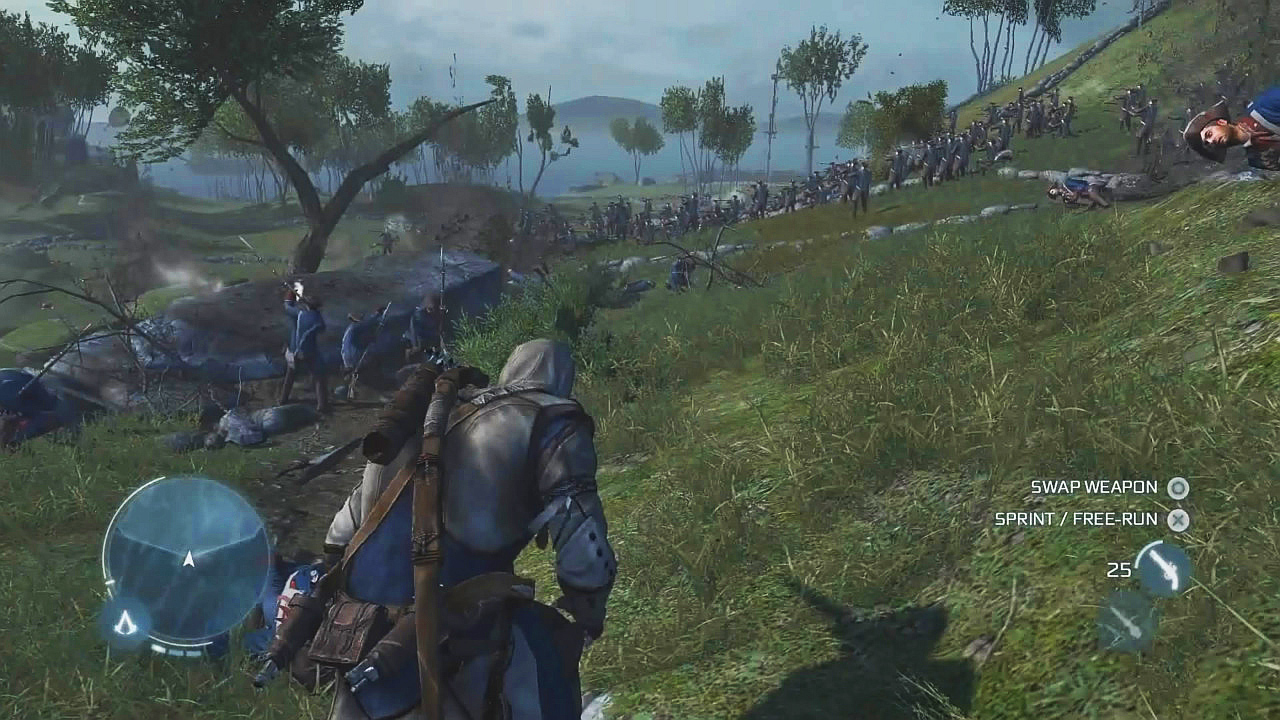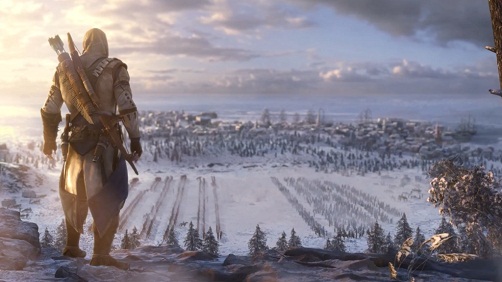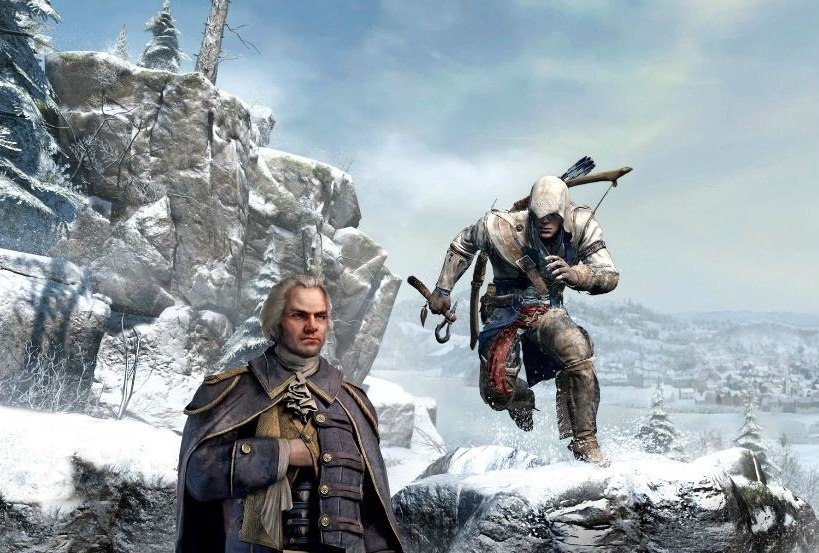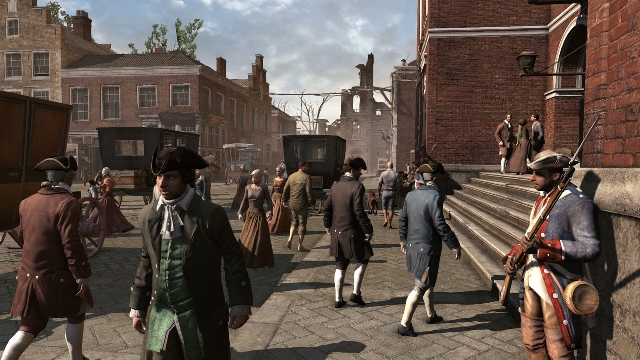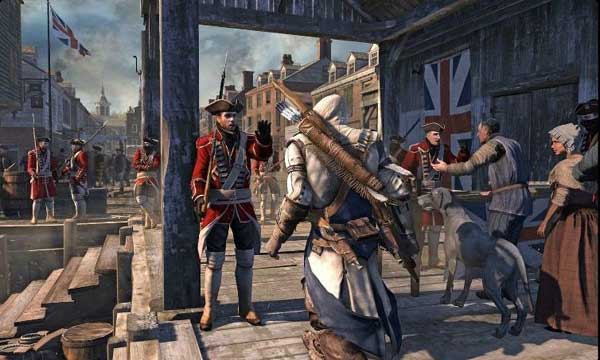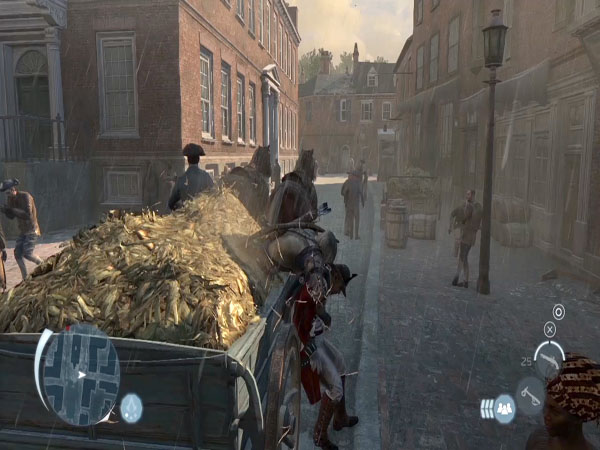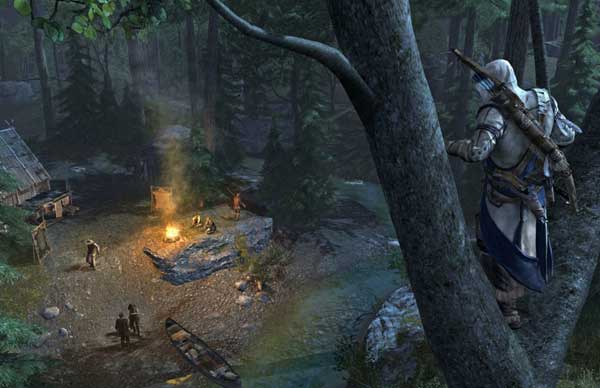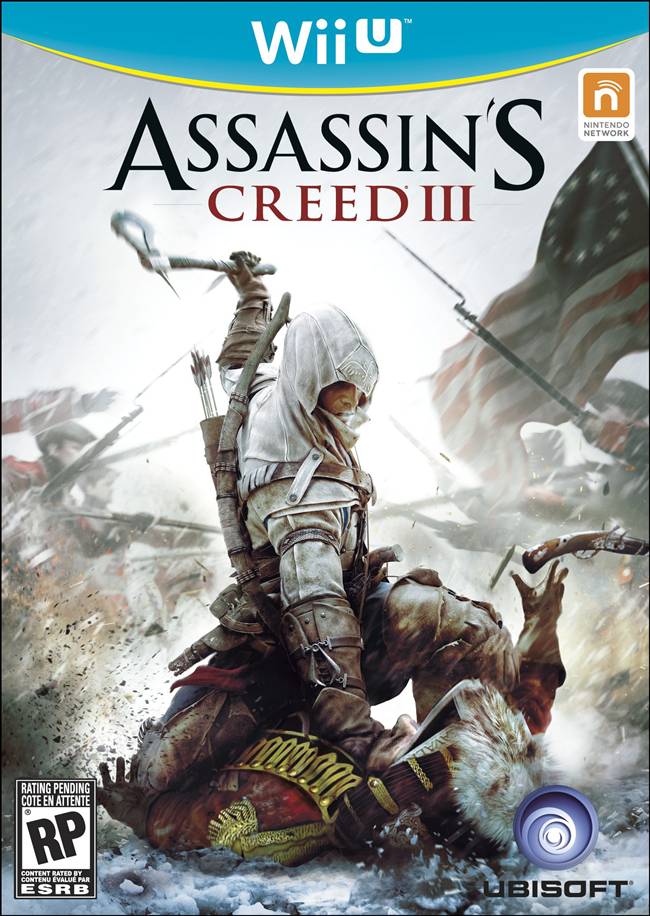Assassin’s Creed III is not Assassin’s Creed II. This needs to be understood at the outset, this needs to be made clear before you delve into this game. Assassin’s Creed II, the sequel to a highly atmospheric game rooted in one of the best concepts in modern gaming, but one that fell flat somewhat, was borderline perfection.
It was a game that achieved everything that it set out to do, and more. It was a game that expanded on the original’s concept, premise, and potential, a game that addressed the flaws of the original, a game that simultaneously, while redeeming the series, also irrevocably moved it forwards. Assassin’s Creed II was a classic. Its direct follow ups, Brotherhood and Revelations, were great games in their own right, but never again will gaming probably have a revelation on par with what Assassin’s Creed II was.
Therefore, that is my longwinded way of saying that no, Assassin’s Creed III is not better than II. If you were expecting it to be, you set yourself up for disappointment. It is not the leap over II that II was over the first one, it lacks the same monumental impact that II had, and in every way possible, it stays in II’s shadow. It is quite like The Dark Knight Rises, a movie that was expertly made and handled in its own right, but doomed to forever be unfavorably compared with its predecessor. So too will Assassin’s Creed III be judged.
And that is unfair. Because after you strip away all the anticipation and unfair expectations that would have been impossible for any game to meet, you are left with an incredible game, a daring game, a game that makes good on the promise of every game that came before, a game that dares to take its story into unconventional directions, a game that decides to chart uncharted territory- literally- with its gameplay. Assassin’s Creed III is a great game, it is one of the best game released this year so far, and easily the most ambitious game in the series. Judged on its own merits, Assassin’s Creed III is breathtaking, exciting, addictive as hell, and bursting at the seams with content.
It is often a victim of its own ambition. Assassin’s Creed III, in a daring step forward, moves away from the jam packed, densely populated urban locales of the previous games in the series by essentially setting itself in the still-being-settled Colonial America. And yes, while you are given nascent American cities like Boston and New York to romp through, the true strength of the game lies in the unsettled wilderness of the Eastern American coast that it allows the player to explore.
And what a wilderness it is. Vast and expansive, there is no place that you can see that you cannot reach. Using the game’s newly refined free running navigation system, you traverse and negotiate logs, trees, cliffs, rivers, bushes, all the while getting distracted by some new place in the distance that you see that you absolutely must reach, or a rabbit or a deer that you must stalk and kill. Or how about that invitation you just received for the brawlers’ club, maybe you can go there and take on a few brawl challenges? Oh, but there is a building barely visible in the distance, under the outcrop of a rock, hidden by trees, wonder what that is? Assassin’s Creed III gives the player a vast, lush, beautiful countryside, glorious to behold, and even better to traverse. And it avoids the trap that other games its size often fall into, in providing the player with a massive world but nothing to do with it. No, in Assassin’s Creed III, you’ll never be short of things to do.
In how big the world is (or how big it seems) and how beautiful it all looks, the game often resembles last year’s runaway hit The Elder Scrolls V: Skyrim. In fact, like Skyrim, you will often be traveling through beautiful, natural organic locales, replete with rivers, rocks, fords, distant mountains, waterfalls, trees of all kinds, wildlife, and more. You’ll see the seasons change, you’ll see a pack of wolves attack deer, or see two elk start fighting each other, you’ll see the tracks you leave in the heavy snow, and see the tracks of everything else that walked through it, which you can follow to wherever they are now.
It’s staggering, it’s overwhelming, and unlike any other setting in an Assassin’s Creed game, it is completely immersive. Considering the heritage of the series in creating staggeringly immersive atmospheric recreations of historical locales, that’s high praise. And the beauty of the Frontier is only furthered by the cities proper, each of them vast, spread out, full of people, speaking to each other in loud voices in authentic language and authentic accents, dirty, grimy, loud, with the distinctive wooden architecture of this period. Being in the cities feels completely different from being in the great wilderness, and all of it goes towards crafting the most believable world an Assassin’s Creed game has had yet.
Aiding the world is the fact that this is the best, most refined, smoothest that Assassin’s Creed has been yet. Ubisoft took all the complaints directed at the previous games to heart, and redid several aspects of the game from the ground up.
The combat, notably, has improved. Previous Assassin’s Creed games had a crippling dependance on defensive combat: you could block and parry, and in your enemy’s moment of weakness, you could respond and strike him down, but trying to attack him first would be of no avail, as you would be blocked and deflected yourself. No more. Now you can attack, block, parry, disarm your opponent, chain blows, chain kills, and basically go on a one man killing rampage. The combat in this game is considerably spruced up, although it is now easier than ever before. It does go towards making Connor feel like a one man Assassin army, but a bit of challenge would have been nice.
The challenge comes from the AI in this game, which is great. Your allies are now much better at everything, from pathfinding to combat itself proper, and often, while you’ve been pre-occupied with taking on just a couple of redcoats, you’ll see that your partner basically took out an entire contingent all by him or herself. It’s great.
What’s also great is enemy AI. In combat, they do their best to flank you, swarm you, and overwhelm you, but they truly shine in the stealth sections, which are now brutal. Unlike in Assassin’s Creed II, they will respond to the slightest sign of suspicious activity, and they will dog you once their suspicions have been roused. Hiding from them should be easy, but they follow you into hiding spots and pull you out, engaging you in combat. And while there are some baffling instances where breaking the line of sight by simply hiding in a corner spot even while the enemies look for you frantically all around, never once turning to gaze at you works, by and large, the stealth sections are better because of how good the AI is. It’s a good thing that, in addition to traditional hiding spots like bales of hay and small crowds, Assassin’s Creed provides new options for hiding too, such as dense undergrowth in the wilderness.
The game introduces a major gameplay element in naval battles, and unlike tower defense in Revelations, which felt tacked on and underdeveloped, these here feel completely fitting in context, and play even better. Undoubtedly among the most exciting parts of the games, the naval combat is dynamic and varied, and includes everything from head on ship battles, to navigation of treacherous seas, to boarding enemy vessels and raiding them. The weather system adds an element of uncertainty and surprise as well, and two segments never play the same. These are a much needed break from the game’s other sections, which, good as they are, often have a tendency to settle into a grind.
The one thing that Assassin’s Creed has always been good at has been the navigation. Classified, quite literally, as free running, the games have seen series protagonists run through uncompromising urban terrain swiftly and fluidly, with some great platforming that looks great to behold. III ups the ante in that regard. The free running is better and more intense than ever before, although you will find that it is hard to properly execute in the cities because of how sprawling and spread out they are, unlike Florence or Jerusalem. In fact, vertically, the urban locations in Assassin’s Creed III are the least impressive, and urban free running in this game would have been the worst of the series yet had it not been for some neat additions, such as the Jason Bourne style ability to jump from rooftops, and through open windows into houses, running out the other side without breaking a stride.
Still, urban free running feels muted. Where it comes into its own in this game is in the wilderness. The trees, the rocks, the cliffs, the outcroppings, the bridges, everything is fair game, and it’s more intense than ever before, more organic, requiring more player input, more deft and subtle adjustments to direction and speed.
It looks even better because of the incredible animations. Assassin’s Creed III has the best and fluidest animations in the series, and possibly for any Ubisoft game ever. That is very high praise, especially when you consider how accomplished games like Assassin’s Creed II and Prince of Persia: Sands of Time were in this regard. They’re smooth, and whether its the combat or the navigation, it feels natural, free flowing, transitioning from one into the other with complete ease, making Connor seem like a thorough badass.
Of course, things do begin to fall apart on the visual level multiple times. Assassin’s Creed III is, as stated, a massive game, and a very ambitious game in what it tries to achieve. And while Ubisoft has done its best to accommodate its vision on machines that are nearly eight years old from the dates of their conception, the simple fact of the matter is, neither the PS3 nor the Xbox 360 is powerful enough to actually support this kind of a game, and it shows. The systems are probably strained to the max, considering how ugly everything has a tendency to look up close. Blurry and muddy textures, pop ins, a very low draw distance, frame rate drops, and some shockingly low polygon models for some objects in the wild- certain bushes and trees are probably outdone by similar foliage in Ocarina of Time- are all a testament to the fact that the game perhaps took on more than it should have.
This is evidenced by the bugs and glitches as well, which are all over the place in the game. From a failure to recognize and load certain trigger events, to just objects floating in the air Skyrim style, Assassin’s Creed III is a buggy game. Perhaps that is excusable, given the scope and size of the game, but given the extensive development period, there is no reason these could not have been ironed out, and they give the impression of the game being rushed, which it most certainly is not.
Back to the graphics, then, we have a beautiful, atmospheric world that looks incredible at a distance, and turns very ugly up close. In that regard also, Assassin’s Creed III invokes Skyrim. Everything is breathtakingly beautiful on a macro level, but on a micro level, things get messy, fast.
The graphics are complimented by the sound design of the game, which is expectedly top notch. From the voice acting, which is spot on and incredible for every character, major or minor (Connor, especially, will win many hearts), to the music, which is possibly the best in the series, everything here adds to the game so much.
The main theme is incredible, echoing the underying tension of the game, and out in the wilderness, when you are just exploring, the complete lack of ambient music draws you in entirely, letting you sink in the sounds of the plants and animals around you, or of you as you trudge through the snow. When there is ambient music, it is suitably relaxed or tense, and in one memorable instance, induces goose bumps, as you listen to the native American music in the background. It’s great stuff.
The one issue I have skirted around so far in the review is the story. Of course, some of this is to avoid spoilers (and believe me, discussing the story in any capacity will inevitably include spoilers), but there is also the fact that the game’s story is, on the whole, a bit of a let down. No, the narrative itself is really good; Connor is a well developed character who resembles the stoicism of Altair more than he does the charismatic Ezio, and everyone around him is memorable as well (if not, again, as memorable as the cast of characters in the Assassin’s Creed II trilogy).
The themes the game explores and tackles are some of the biggest and best yet, with an underlying idea that there is no absolute morality, as we follow Connor’s shifting alliances, and his troubled relationship with his father. In fact, there are even multiple mini WTF moments that the series usually reserves for the endings, within the first few hours.
The problem is in how the story is structured. It’s incredibly slow paced and takes forever to get to the point. The game has twelve sequences total, and the first six of these can be viewed as a simple prologue. When it does finally get to the narrative proper, its explosive, weaving real historical events into its fiction masterfully, but it drags a lot for the first half, and the story suffers as a result.
The problem is, the game has a very heavy focus on its story, and it suffers as a result. Oftentimes, it feels like a collection of cutscenes, interspersed by glorified interactive cutscenes almost misleadingly labelled as missions, which require almost nothing more of you than to walk from point A to point B, or engage in a QTE, or at best, trail someone at a safe distance. Even otherwise, the missions in the game don’t seem to be too varied, and all follow a general pattern in their progression; the fact that they’re almost never as long as missions in Assassin’s Creed II adds insult to the injury. Of course, there are the secondary objectives that you are given, that are necessary to achieve full synchronization, but not to progress through the story, and they usually make the missions more interesting, but on the whole, it’s a bit disappointing that the game fails to live up to II and Brotherhood in that regard.
There is also the fact that the game often lets the story and progression define the flow of gameplay and missions; you might be whisked away inexplicably to an entirely new location that didn’t even exist on your map till then because the story demanded it. The missions might be stifled or too repetitive because the story leaves no room for nothing else. Sometimes, the game won’t even let you explore your surroundings because the mission won’t let you. It feels more restrictive than the original Assassin’s Creed and its sequels, which is a bit of a shame.
And what of Desmond’s story? People tend to criticize the frame narrative around Ubisoft’s games, or to ignore it entirely, but Desmond is an integral part of the series who cannot be ignored, and never more than in this game. His story, of course, is important, given that this is the conclusion, but there are also instances when you get to play as him, and they play well, although the promise of playing as a modern day Assassin that has always been hinted at since the first game is never made good upon, outside of one short but memorable sequence.
Then there is also the fact that over the course of the last four games, Desmond’s story has raised too many questions, more than the writers could perhaps have managed. And indeed, it shows, as the ending of the game is a disappointment, a letdown after five years and as many games’ worth of teasing. It is shockingly bad in quality, and will inevitably draw some ire, like Mass Effect 3’s ending did.
Thankfully, that never matters. The game proper is too much fun, and filled with so much fun to do. Hunting in the frontier, playing in the bars and taverns scattered throughout, collecting ingredients, finding lost pages of an almanac or eagle feathers, joining clubs, boating, engaging in naval battles, eavesdropping on people, delivering letters, and more, so much more. Then there is the game’s multiplayer mode. First introduced in Brotherhood, the multiplayer mode here returns with a vengeance, better and stronger than ever before, adding even more to the game’s already formidably vast play time.
Really, this is a massive game. It is an excellent game. Its scope and ambition are matched by none, and it often falters because of that. As a game, it is more daring than any other entry in the franchise; and yet, because of certain problems that are more major than anyone would have liked, it falls short of achieving the same kind of greatness that Assassin’s Creed II did. But that isn’t a knock against this game. Few games ever manage to do what II did, and really, this game should be judged on its own merits.
In which case, it is an incredible, vast, expansive game, with addictive gameplay, great atmosphere, no dearth of content, one that will keep you busy for a while, and one that will have you genuinely pondering the implications of its story for a long time to come.
In the end, that is the mark of a great game.
Assassin’s Creed III – second opinion by Bojeeva
It’s always the way, isn’t it? You wait for a game that teaches you how to hunt and assassinate people to be released then two come along at once! But while bald-headed Agent 47 of Hitman Absolution may know a thing or two about killing, he can’t free run, hunt bears or set sail for spectacular sea battles without so much as breaking a sweat, now can he?
After more than three years in development, Ubisoft’s much-anticipated conclusion to the Assassin’s Creed series is finally here… but was it worth the wait? Hell yeah. Killing people has never felt so satisfying.
Assassin’s Creed III had already smashed records prior to its release, taking the mantle of Ubisoft’s most pre-ordered game ever – with worldwide figures doubling those of the previous record holder Assassin’s Creed Revelations. It certainly had a lot to live up to – and it’s arguably the best game in the series.
As usual, you start as the “as-mundane-as-he-sounds” Desmond who, along with his scientist buddies, is once again caught up in a bit of memory-based time travel. He’s transported back to the days of the American Revolution to piece together his fragmented memories. The story’s a little convoluted but stick with it…
The opening scenes set the stall for what is one of the most compelling adventures of recent years. From the moment you switch from the shoes of series stalwart Desmond in the present day and become embroiled in a murder plot at the Theatre Royal in London’s Covent Garden circa 1754 you’re hooked. From that moment on, it’s a rip roaring journey across the US in the lead up to the American Revolution.
Thanks to the new Anvil Next game engine, the visuals are phenomenal – with highly detailed environments and plenty of variety.
Just sit back and gawp at the animations, weather effects and the huge number of characters onscreen at any time; it’s all very impressive. There are loads of different settings and locations, such as the rapidly developing homestead in the country, to the hustle and bustle of the city streets (you can even run through houses now to avoid enemies), it really is an achievement – and we mustn’t forget the nautical scenes, which are absolutely sublime. The way the waves ebb and flow, with the weather lashing down on the deck – all while you’re in the midst of some tactical game of cat and mouse with a rival’s vessel. It’s both exhilarating and awe-inspiring at the same time, and certainly among the highlights of the entire Assassin’s Creed series (and that’s saying something).
Sure, close up, some of the textures and detail are a little shaky but you’re unlikely to really notice or care while your leaping from a tree top on to your unsuspecting prey. You can almost sense that Ubisoft are itching to get their mitts on next gen hardware to push the boundaries even further. It’s a small point perhaps, but the facial detail really impressed me too; the realistic eyes and accurate lip synching really helping to draw you in and add some personality to the myriad characters.
Besides the actual gameplay, the cut scenes and voice acting are decent too. I normally abhor lengthy cut scenes but found myself listening intently as the plot unfolded. It’s a nice touch to have background music and effects in each of the cities too, and the fact that there is a diverse range of accents really adds some meat to the weird and wonderful people you meet. They’ve even recorded authentic native dialect and include subtitles through some of the chapters! It’s also hugely atmospheric when you overhear conversations as you wander about the streets, with different voices chatting away – it really is a living, breathing environment.
Even more than the previous games, you really do get a sense of space and scale this time round too. While the confined streets and crowd scenes of previous games are included, it’s the enormous playspace of the countryside that really makes this stand out from the crowd. There’s a real sense of freedom as you yearn to see what’s over the hill up ahead or what that building is in the distance. The fact you can hunt as you go, just makes the experience even more enjoyable.
And it’s never been so satisfying to leap from a tree, dagger drawn, to impale an unsuspecting rabbit below. Cute woodland creatures haven’t had it so bad since Dr Robotnik got his thrills by chasing down all of Sonic’s friends. This is certainly a game that draws on other titles and melts them down into one mouthwatering package. The hunting elements and wilderness evokes memories of Red Dead Redemption, the free running reminds me of Prototype, the hugely detailed world of Skyrim and the ruthless killing is reminiscent of the aforementioned Hitman series. Assassin’s Creed III, however, arguably does everything just a little bit better than its peers.
Initially, you are thrust back to the 18th century to play as Haytham Kenway – father to the game’s main protagonist, a young, half-English, half-Mohawk called Ratonhnhaké:ton – or Connor to his friends. It’s tricky to say much more without revealing the plot and spoiling the experience but suffice to say, you really do develop an emotional bond with Connor and quickly forget that Ezio et al are but a distant memory.
The first few sequences act as a lengthy tutorial, explaining the various controls, movements, weaponry and abilities of your character.
The fighting elements have been much improved and somehow, the multitude of button presses and combinations required to get Ezio and Altair about the place don’t seem remotely complicated this time round. The rejigged combat system, with all its counters and attacks, are lovingly animated and appear seamless in action. Perhaps it is all a little too easy to dispatch a group of bad guys this time round but who cares!
Importantly, the free running element – the crux of the gameplay – is flawless, especially as you now you also have the ability to scamper up trees and jump from branch to branch as well as buildings and spires. And yes, it’s still just as thrilling diving from a steeple into a hay cart as it was in the first game.
Besides your usual swords and hidden blades, there are plenty more weapons at your disposal too. Besides the bow, tomahawk and rope darts, Conner has plenty of other goodies in his inventory. Perhaps most important are the snares and bait that allow him to hunt in the woodland.
There’s just so much to distract you from the main missions that you’ll be glued to the screen for ages. There are also the obligatory collecting objectives and side missions to add some variety and longevity. What’s more, there’s the exciting multiplayer mode available too.
From London to New York, Lexington to Bunker Hill, whether wading through the thick snow or basking in the sunlight on a rooftop before partaking in a spot of parkour, Assassin’s Creed III has something for everyone. Who’d have thought the American Revolution would be a rip-roaring theme for a video game? Where else can you combine stealth with all out fighting, a powerful narrative, an amazing atmosphere – and meet the likes of George Washington and Benjamin Franklin??? Assassin’s Creed III is a triumph and definitely one of the highlights this year. Buy it.
This game was reviewed on the Xbox 360.
Improved combat; great AI, friendly and enemy; the game world is incredible; the naval battles play great; the animations are swift and fluid, and at a distance, graphics look great; great music; great voice acting; Connor's story is sweet and moving, if a little slow; Desmond gets some screen time, and it doesn't suck; the multiplayer mode is better than before; stealth is harder, and better; free running best and most intense in series, especially out in the wilderness; you will never run short of things to do in this game, because there is simply too much
The combat is so good, the game starts feeling a bit too easy; baffling bugs and glitches; graphical problems, ranging from pop ins, low draw distance, bad textures and low quality models, and frame rate drops; the story is slow paced; Desmond's story is hard to care for, and the ending will universally leave you cold; story and characters compare unfavorably to the Assassin's Creed II games; urban free running feels stilted; heavy focus on story and narrative leads to the game feeling too restrictive or even QTE heavy at times









